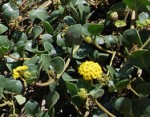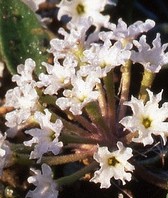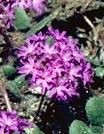 Abronia (a BRO ni a) from the Greek word abros, meaning delicate
Abronia (a BRO ni a) from the Greek word abros, meaning delicate
The bracts beneath the flowers of this group of plants is delicate, giving them this generic name. Abronia is a genus in the four o’clock family (Nyctaginaceae) that also includes bougainvillea. The genus is also known as wild lantana and sand verbena although it is not related to either lantanas or verbenas. It includes about twenty speices of annuals and herbaceous perennials native to western North America where they grow on dry sandy soil. Many are rare and some are endemic to a small area.
Here are three examples of Abronias:
 A. latifolia
A. latifolia
Also called yellow sand verbena this perennial is native to the coastal beaches, dunes, and scrub of the west coast of north America from southern California to the border between Canada and the US. The flowers lack petals but have showy yellow bracts and are carried in rounded clusters from March to October. The plants grow four to five inches high and form thick mats. It is the only Abronia with yellow flowers.
 A. ammophila
A. ammophila
Yellowstone sand verbena, or Wyoming sand verbena, is endemic to Yellowstone Park where it grows just above the maximum splash zone along the shoreline of Yellowstone Lake. At the present time there is concern for the survival of the population.
 A. maritima
A. maritima
This perennial is also called red sand verbena and is native to the coastlines of southern California where it grows on stable sand dunes. It needs the salt spray from the ocean surf and can not tolerate fresh water or prolonged drought. The fleshy tissues store salt and form thick mats with bright red, pink, or purplish flower clusters.